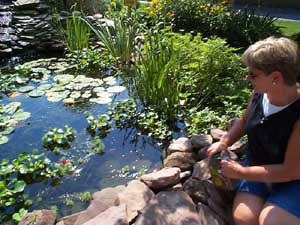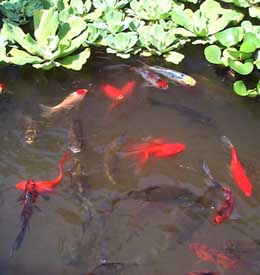
Four years ago Kathy and David Diedrich of Burritt Road in Hilton took a look at a four-foot high rock garden in their backyard and imagined a waterfall. Today, a stream of water cascades over several ledges into a 16 feet by 20 feet water-lilied garden pool complete with koi, fish known in Japan as "living jewels," and different kinds of goldfish. Yellow iris, lotus and water hyacinth, which simply floats on the surface, are reflected in the water on this sunny afternoon. The effect is irresistable ... a truly beautiful environment as close to nature as possible. Landscapers know that the benefits of a water feature in the garden are more than the aesthetically-pleasing environment and luminous surface. A healthy water garden cools breezes blowing over its surface, and with the addition of a fountain or watercourse, can block the sound of road traffic and lawnmowers, transforming the backyard into a magical space for its owners and all who visit. Those visitors also include grosbeaks, finches and occassional herons as well as dragonflies, bull frogs and butterflies. "First I had to do a lot of reading and a lot of planning," Kathy explained. "And it takes a lot of work to create and maintain it -- actually, it takes the two of us to take care of it." The Diedrichs live on David's family farm, the Luther A. and Isabel Diedrich farm which originally was planted in orchards. Their garden space is sited directly to the south, less than 25 feet from the back of their house. Mature maples and medium-sized mountain ash trees give the water garden additional shade. A pea gravel bed leads directly to the edge of the pool which required more than three tons of rock, primarily fieldstone, which rings the pool and forms the waterfall. Visitors enter the water garden through a cedar arbor which gives the whole environment a "framed" focus. "It's nice to sit in the family room and hear the frogs croaking," said David who, along with sons Eric and Paul, did the heavy construction work on the garden pool. "And we have no mosquitoes," Kathy said. "The fish will eat the mosquito larvae as well as the algae that forms in the water. You can see the plants bobbing up and down as the fish nibble on them." Koi and goldfish are omnivorous, eating tadpoles, algae, worms and insects. Belonging to the carp family, they are bottom grubbers, constantly feeding, but Kathy and David feed a commercial fish food to their more than 100 fish. "Koi are amazing," she said. "They slide right up on the lily pads." In fact, Koi are one of the world's most amazing fish, easily living 60 or more years! They can be expensive, too, with some particularly colored koi fetching in the thousands of dollars (Visit www.qualitykoi.com for info). The Diedrichs' pond is 30-36 inches deep -- deep enough for fish to overwinter. Fish need water below the frost line to survive. They will die if the pond freezes solidly. A good knowledge of aquaculture is necessary to successfully keep fish in a water garden, but a good place to start is Sara's Farm Market & Garden Center on East Avenue in Brockport. "Every Sunday at 1 p.m. we have a free 'Pond Class,' " said Frank Kepler, whose family founded and owns Sara's, one of Monroe County's sources of water garden plants, fish, garden scupture, water pumps, rock, stone and expertise. In addition to Sara's perennial stock and garden accessories, on site are both a 20 ft. by 25 ft. garden pond with waterfall and more than two acres of landscaped gardens. There are many varieties of floater foliage (waterlilies, fairy moss); oxygenator plants (foxtail, anarchis); ornamental fish (a one-inch fish can survive in 3-5 gallons of water); and marginal plants (zebra rush, hardy yellow iris, caltha marsh marigold). "We've developed a pond-stocking formula," Frank said, "which is needed to balance the pond for cleaner water." "You've got to do what God did," he said. "The garden is part of creation. You want to re-create this in the water garden." Frank says that sometimes people are unsure of what's needed, but "it's like anything new, intimidating at first, but after a simple pond class, you find out it's do-able." Balancing a pond is built on an understanding of the nitrogen cycle of biological filtration which affects the health of fish and plants. Fish and decaying plants release nitrates including ammonia in the water which are transformed into healthy nitrites through beneficial bacteria. The gardener must implement various tactics to enhance the bioactivity of the garden pond by encouraging certain aquatic plants and other practices such as cleaning out the pond, usually in the spring. (www.pondz.com) Not convinced yet? One more question: can a garden pond increase mosquito production in this age of West Nile Virus? According to the U.S. Center for Disease Control, research on the mosquito-carried disease indicates mosquitoes need five to ten days in standing water to breed. Leaf-filled rain gutters, bird baths, small containers that hold water for at least one week are the primary culprits, not water gardens with moving water. Sluggish, standing water, impoundments and container water are prime breeding grounds, but the number one predator of mosquito larvae are fish. Marshes that have channels where fish can get through are among the healthiest and most productive ecosystems on earth due to the constant water charge and recharge. For more on water gardening and the stone and rock needed, in addition to Sara's, Bergen Water Gardens and Nursery on Buffalo Road in Churchville and Harris Garden Center on Buffalo Road are also places to get involved as well as Hilton stonemason Joe Rauber on Hinchey Road who has built many water features, rock retaining walls, patios and watercourses. For more on the stone, brick and rock needed, visit Miller Brick on Ridgeway Avenue and Weckesser Brick in Gates. NOTE: Barbara Carder Pierce is a sometimes gardener who is inspired by the ponds and marshes located along the lakeshore in North Greece. |


